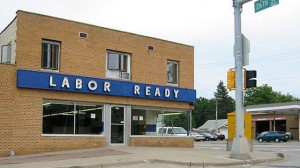This personal account about life as a blue collar temp was produced with support from the Economic Hardship Reporting Project and first published in Mother Jones.
It’s still dark when I show up at the Labor Ready storefront in downtown Oakland, California, just a few blocks from the plaza where the Occupy crowd threw up its tents against the one percent. From the sidewalk, the place looks vaguely illicit, with minimal signage and floor-to-ceiling shades that remain drawn 24/7. Later, I will come to think of this as the company “look”— unwelcoming and easy to miss — often tucked alongside a check-cashing business or payday lender.
The office opens at 5:30 a.m., but job seekers start appearing an hour early, hoping to snag a top spot on the sign-in sheet. By the time I arrive, 20 people, all but one of them men, are already inside — the space is essentially a waiting room with a long counter — standing or slouching in white plastic chairs. Behind the counter sits an African American woman with short hair and a bearing that suggests a low tolerance for bullshit. “I can’t remember the last time I got eight hours sleep,” a bleary-eyed man behind me announces to no one in particular.
After signing in, I grab a chair from a stack in the corner and take a seat, studying a sign that implores me to be “true” and “passionate” and “creative.” In reality, passion and creativity have nothing to do with it. Labor Ready provides warm bodies for grunt work that pays minimum wage or thereabouts. “Here’s a sledgehammer, there’s the wall,” is how Stacey Burke, the company’s vice-president of communications, characterized the work to Businessweek back in 2006.
It’s not a pretty formula, but it works. With 600 offices and a workforce of 400,000 — more employees than Target or Home Depot — Labor Ready is the undisputed king of the blue-collar temp industry. Specializing in “tough-to-fill, high-turnover positions,” the company dispatches people to dig ditches, demolish buildings, remove debris, stock giant fulfillment warehouses — jobs that take their toll on a body. (See “I Was a Warehouse Wage Slave.”) And business is booming. Labor Ready’s parent company, TrueBlue, saw its profits soar 55 percent last year, to $31 million, on $1.3 billion in sales. The Bureau of Labor Statistics predicts that “employment services,” which includes temporary labor, will remain among the fastest growing sectors through 2020. TrueBlue CEO Steve Cooper, who took home nearly $2 million last year, predicts “a bright future ahead.”
The woman behind the counter, whom I’ll call Natalie, turns on a television and pops in a video that job-seekers must tolerate every morning no matter how many times they’ve seen it. On the screen, a man who lost his arm in a workplace accident reminds us to be safe. A sign on the wall to my left states the number of consecutive days the branch has remained accident-free—330, which, given the physical nature of the work, almost seems too good to be true.
At one end of the room, a slender black man with a shaved head is leading an animated discussion of current events. “If it was a brother coming across the border, they would have sealed that shit up,” he says. The people around him nod. Someone comments that Latino immigrants have it easy.
“No, I wouldn’t say that,” the man responds. “Don’t forget: They have no recourse if they get hurt.” And “they get 10 bucks an hour, but the men picking them up on the corner are going to get 30 or 40 bucks an hour out of them.”


